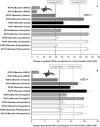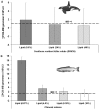Projected amplification of food web bioaccumulation of MeHg and PCBs under climate change in the Northeastern Pacific
- PMID: 30194394
- PMCID: PMC6128847
- DOI: 10.1038/s41598-018-31824-5
Projected amplification of food web bioaccumulation of MeHg and PCBs under climate change in the Northeastern Pacific
Abstract
Climate change increases exposure and bioaccumulation of pollutants in marine organisms, posing substantial ecophysiological and ecotoxicological risks. Here, we applied a trophodynamic ecosystem model to examine the bioaccumulation of organic mercury (MeHg) and polychlorinated biphenyls (PCBs) in a Northeastern Pacific marine food web under climate change. We found largely heterogeneous sensitivity in climate-pollution impacts between chemicals and trophic groups. Concentration of MeHg and PCBs in top predators, including resident killer whales, is projected to be amplified by 8 and 3%, respectively, by 2100 under a high carbon emission scenario (Representative Concentration Pathway 8.5) relative to a no-climate change control scenario. However, the level of amplification increases with higher carbon emission scenario for MeHg, but decreases for PCBs. Such idiosyncratic responses are shaped by the differences in bioaccumulation pathways between MeHg and PCBs, and the modifications of food web dynamics between different levels of climate change. Climate-induced pollutant amplification in mid-trophic level predators (Chinook salmon) are projected to be higher (~10%) than killer whales. Overall, the predicted trophic magnification factor is ten-fold higher in MeHg than in PCBs under high CO2 emissions. This contribution highlights the importance of understanding the interactions with anthropogenic organic pollutants in assessing climate risks on marine ecosystems.
Conflict of interest statement
The authors declare no competing interests.
Figures







References
-
- United Nations Environmental Programme. Protecting the environment from Persistent Organic Pollutants and other persistent toxic substances. UNEP’s Action in the Framework of the Global Environment Facility (UNEP 2002).
-
- United Nations Environmental Programme. Global Mercury Assessment2013: Sources, Emissions, Releases and Environmental Transport. UNEP Chemicals Branch, (UNEP 2013).
Publication types
MeSH terms
Substances
LinkOut - more resources
Full Text Sources
Other Literature Sources
Medical
Molecular Biology Databases

